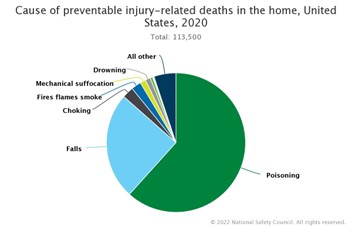Injuries and accidents happen all the time, everywhere. Most of the time, the victim’s life depends on a quick, appropriate medical response. Some other times, an adequate follow-up and treatment are necessary to ensure the victim’s recovery. To what extent can technology help healthcare providers or witnesses of accidents respond promptly to an emergency? Can apps improve the efficiency of treatments? We accept the challenge and will try to answer these two questions using relevant examples.
Common types of accidents
From vehicle accidents to domestic mishaps or accidents – such as cuts, slips, or falls – at the workplace, personal injuries claim thousands of lives each year. Before we take a look at how software can help turn a potentially fatal injury into a non-fatal one, it is beneficial to know how and where accidents happen.
Domestic accidents
Most of us perceive our home as our safe, personal oasis. But does reality match our perceptions and expectations? Statistics clearly demonstrate that our homes are the most common locations for unintentional accidents to happen. According to NSC, in 2020 alone, there were 113,500 registered deaths in the U.S. as a result of a home accident. Let’s take a look at the main accident causes:
Accidents in the workplace
While it is true that some workplaces can be more dangerous than others, it is also true that no workplace is hazard-free. According to ILO, 2.3 million people around the globe succumb to work-related diseases and accidents each year. That translates into an impressive rate of 6000 deaths a day. According to EUROSTAT, in 2019, the EU registered 3 408 fatal accidents at the workplace. The construction sectors together with transportation, manufacturing, agriculture, and forestry and fishing accounted for no less than 64.4 % of all the fatal accidents in the workplace.
Road traffic injuries
According to WHO, the lives of over 1.3 million people are cut short each year as a consequence of road traffic crashes. What’s more, the leading cause of death for people aged 5 to 29 are road traffic injuries. WHO’s real-time data visualization map regarding deaths on the world’s roads contributes irrefutable information.
Code to embed the map on website: <iframe src=’https://extranet.who.int/roadsafety/death-on-the-roads?embed=true#ticker/all_road_users’ style=’border: 0; width: 100%; height: 700px’></iframe>
Software for accidents, first aid, and treatment
Despite the extensive measures taken to reduce fatalities, accidents and injuries keep claiming an alarming number of lives. This is where technology comes onto the stage with a well-determined purpose: save lives. Let’s take a look at some relevant examples.
First Aid – IFRC
Available for Android and iOS, this free app boasts a user-friendly interface and grants access to valuable information on a wide variety of emergency factors such as wounds, fractures, diseases, earthquakes, tornadoes, etc. Among its features, we can highlight:
- Step-by-step instructions that cover multiple everyday first aid scenarios
- Integrated with emergency numbers
- Videos and animations for fun and easy learning
- Content can be preloaded and accessed any time, without requiring an Internet connection
WebMD for Android and iOS
The purpose of this app is to provide users with access to trusted health information. We are talking about a general healthcare app that offers a wealth of interesting features:
- Fully customizable
- It allows users to check their symptoms and learn more about potential medical conditions
- Provides medically reviewed information about the causes, symptoms, and treatment of a wide range of conditions
- User-friendly guide for medical emergencies
- Provides access to an extensive database about drugs and their usage, side effects, etc.
- Access to local health listings
- Contains a pill identification tool
- An integrated medication reminder helps users take their medicine always on time
- Through WebMD Rx, this app gives users access to important pharmacy chains, allowing them to compare prescription drug prices
- The Drug Interaction Checker allows users to identify and avoid potentially dangerous combinations of prescription medications
Medical Tracker (Schoolcomms)
This secure, web-based platform allows schools to report and record any type of incident, illness or injury and manage care plans, medical conditions, or COVID-19 flow tests in a matter of seconds. Among its key features, we can highlight:
- Incidents can be reported as they happen
- Allows schools to create actionable reports by identifying common injuries, activities, locations, and times, thus helping schools take preventives measures
- Automated notifications to staff, parents, and carers
SOSmart
Designed to save lives, this free app integrates a sophisticated algorithm developed from real car crash data. What this app does is use the smartphone’s Accelerometer and GPS sensors to send an emergency notification to the pre-selected emergency contacts. Since the notification includes your exact locations, your contacts can promptly notify the emergency services. Let’s take a look at this app’s main features
- Easy to install and use
- Manual or automatic modes for crash detection monitoring
- The web platform allows institutions to permanently monitor emergencies
- Integrated panic button that notifies your contacts and the pertinent institutions
- If your emergency contact has the app installed as well, a loud alarm is triggered to call their attention
- Thanks to its performant algorithm, the app is able to differentiate a serious traffic accident from a minor shock, a phone crash, or braking
First Aid for Emergency (New Zealand Red Cross)
Designed as a free, user-friendly, and comprehensive pocket guide, this app provides valuable step-by-step advice on what to do when faced with an emergency.
- Preloaded content that grants instant access to information
- Easy to understand animations and videos to get you acquainted with updated CPR and First Aid guidelines
- Allows users to call local emergency numbers
- Provides expert advice on how to prepare for common emergency situations
Heart Hero (iBeat, Inc)
In case of a cardiac arrest, early CPR and AED significantly increase the victim’s chance of survival. With that in mind, iBeat designed Heart Hero, a free mobile app that turns ordinary people into heroes. These are the app’s main features:
- Users can learn CPR with the help of instructional videos, quizzes, and reading assessments
- Helps users find the nearest AED and add it to the database. In case of an emergency at home, work etc., users will know exactly where to look for this life-saving tool
- Users can put their chest compression accuracy skills to a test with the app’s tempo challenge game
These examples prove that software development companies have understood that aspects such as safety or wellness have taken on new meanings in the pandemic and post-pandemic reality. If you want to discover more useful apps, check out this article too: For Hospitals And Patients: Wellness Software In 2022
Wrap up
Life is unpredictable. Sometimes, even the simplest routine can lead us to a situation in which we – or someone close to us – might need help. Most of the time, bystanders are key to reducing the number of fatalities either by acting themselves or notifying the pertinent emergency services. Fortunately, apps such as First Aid – IFRC or Heart Hero have been specifically designed to offer specific instant training, turning ordinary people into tech-caped heroes. As we have seen, technology can now improve accident outcomes by reducing the medical response time and empowering ordinary people to react adequately to the most common first aid scenarios. Professional software development companies –such as Elinext – have been dedicating their efforts, innovative skills, and expertise to developing software solutions for the healthcare industry. Such companies can turn your ideas into a life-saving reality.










